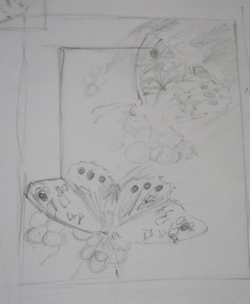Little Brother
 |
| Atlantic Puffin (image from wikipedia) |
 |
| Little Brother © Lisa Treadwell |
Atlantic puffins like to nest in burrows they dig themselves, or use those made by rabbits. Lining these with grass and leaves the puffin couple make a cosy home to raise their chick, only one egg being laid. Both parents bring fresh fish back to the hungry puffling, efficiently holding several at a time, sometimes more than a dozen. The beak is hinged just so the upper and lower bills can clamp at various angles allowing the collection of more than one fish at a time. The puffling grows quickly on all this protein fledging in about six weeks. The youngsters stay under ground and when they are big enough they leave the burrow one night and head out to open sea remaining their for five years whilst maturing ready to raise their own pufflings. Puffins arrive at their breeding sites in early spring and leave in August to spend the winter at sea.
Bright orange legs and feet, the colourful bill and eyes that are accentuated by dark blue skin above and below giving the triangular appearance and by pale grey cheeks, earn the stocky little puffin the nickname ‘Clown of the Sea’. A group of puffins being a ‘Circus’.
 |
| Little Brother © Lisa Treadwell |
Three species of puffin exist, the horned and the tufted puffin living around the pacific. All are members of the auk family. My sculpture was based on the Atlantic puffin Fratercula arctica. I wanted to capture what it is about this very charismatic and appealing bird, with a beak full of fresh fish you can imagine a feeling of pride as this stout little bird presents the catch to the young puffling.
The sculpture is made of laburnum wood, copper pipe for the beak with solder to seam it together and just give the suggestion of the arrangement of colours on an actual beak. The fish are of aluminium can. The eyes copper and the legs welded mild steel. The puffin sits on a piece of Portland Roach stone, the top layer of stone in the ‘Portland Formation’. This is a fossil rich limestone, very appropriate you can see the fossils of sea shells in this piece of stone.
The sculpture is exhibited at the National Exhibition of Wildlife Art until 2 August 2015:
http://www.newa-uk.com/pages/home.php
If you would like to know more about puffins take a look at these links:
https://www.seabird.org/wildlife/seabirds/puffin/12/26/46
http://www.rspb.org.uk/discoverandenjoynature/discoverandlearn/birdguide/name/p/puffin/
https://en.wikipedia.org/wiki/Atlantic_puffin
More about Portland stone:
http://www.dorsetgeologistsassociation.com/Portland-Stone/Portland_Stone_Document_-_7_June_12.pdf
To see more of my work visit:
www.lisatreadwell.co.uk











